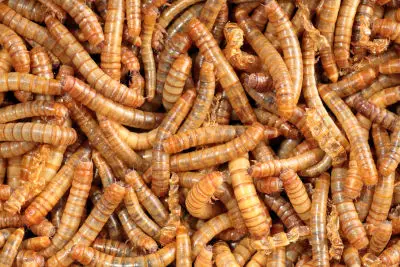What Can I Use Instead of a Heat Lamp for Reptiles? Alternative Heating Options for Your Reptile’s Comfort
Reptiles require particular environmental conditions to thrive in captivity, and heat lamps are essential in providing them with the warmth they need. However, these lamps can be expensive, and their use can lead to health problems for reptiles. Therefore, it is crucial to consider alternative heating methods that can provide the same benefits as heat lamps.
One alternative to heat lamps is ceramic heat emitters (CHEs). These devices emit infrared heat, which is similar to the heat produced by heat lamps. They are also more energy-efficient and do not emit light, making them ideal for nocturnal reptiles that require darkness to sleep. CHEs come in different wattages and sizes, making them suitable for different types of reptiles.
| Are these foods dangerous for your Beardie? | |
| Avacado? Click here to learn, from this guide, if this food is dangerous |  |
| Superworms? Click here to learn, from this guide, if this food is dangerous |  |
Another alternative to heat lamps is radiant heat panels (RHPs). These panels produce heat through infrared radiation and are mounted on the ceiling or walls of the enclosure. RHPs are more expensive than heat lamps or CHEs, but they are more durable and require less maintenance. They also do not produce light or noise, making them ideal for sensitive reptiles such as snakes.
Understanding Reptile Heating Needs
Reptiles are cold-blooded animals, which means that they cannot regulate their body temperature like mammals. They rely on external heat sources to maintain their body temperature and metabolic activity. In the wild, reptiles bask in the sun or hide in the shade to regulate their body temperature. In captivity, it is essential to provide reptiles with an appropriate heat source to keep them healthy and active.
The ideal temperature range for reptiles varies depending on the species, but most reptiles require a basking area with a temperature of 85-95°F (29-35°C) and a cooler area with a temperature of 75-85°F (24-29°C). It is important to provide a temperature gradient so that the reptile can move between the warm and cool areas as needed.
Heat lamps are a popular choice for providing heat to reptiles, but they can be expensive to run and may pose a fire risk. Fortunately, there are several alternative heat sources that can be used instead of heat lamps.
One alternative is ceramic heat emitters, which are similar to heat lamps but do not emit light. They are more energy-efficient than heat lamps and do not pose a fire risk. Another option is under-tank heating pads, which are placed under the tank to provide heat from below. These are particularly useful for nocturnal reptiles that do not require a basking area.
Infrared heat panels are another option for providing heat to reptiles. They emit infrared radiation, which is absorbed by the reptile’s body, providing a gentle and even heat source. They are energy-efficient and do not emit light or pose a fire risk.
Overall, it is important to understand the heating needs of your specific reptile species and provide an appropriate heat source that meets those needs. By doing so, you can ensure that your reptile remains healthy and active in captivity.
Natural Heat Sources
When it comes to providing heat for reptiles, there are natural heat sources that can be used as an alternative to a heat lamp. These sources include sunlight exposure and room temperature control.
Sunlight Exposure
Sunlight exposure is a great way to provide heat for reptiles, especially during the day. It is important to ensure that the reptile’s enclosure is placed in a location where it can receive direct sunlight for at least a few hours a day. This will provide the necessary warmth and UVB radiation that reptiles need to thrive.
However, it is important to monitor the temperature inside the enclosure as it can quickly become too hot, causing harm to the reptile. It is recommended to use a thermometer to ensure that the temperature does not exceed the recommended range for the specific species.
Room Temperature Control
Another natural heat source for reptiles is room temperature control. This method involves controlling the temperature of the room where the reptile is kept. This can be done using a thermostat or by adjusting the temperature of the room manually.
It is important to ensure that the temperature is kept within the recommended range for the specific species. This can be achieved by using a thermometer to monitor the temperature inside the enclosure and adjusting the room temperature accordingly.
While natural heat sources may not provide as much heat as a heat lamp, they can be a great alternative for those who want to provide a more natural environment for their reptile. It is important to research the specific needs of the reptile species to ensure that the appropriate natural heat source is being used.
Artificial Heat Sources
Reptiles require heat to regulate their body temperatures, and a heat source is essential for their survival. While heat lamps are a popular choice, there are other artificial heat sources that can be used as well.
Ceramic Heat Emitters
Ceramic heat emitters (CHEs) are a popular alternative to heat lamps. They emit infrared heat, which is absorbed by the reptile’s body and helps regulate their temperature. Unlike heat lamps, CHEs do not emit light, making them ideal for nocturnal species.
CHEs come in different wattages and can be used with a thermostat to regulate the temperature. They can be placed inside or outside the enclosure, and due to their design, they do not emit harmful UV rays.
Under Tank Heaters
Click here for the price, on Amazon #Ad
Under tank heaters (UTHs) are another option for providing heat to reptiles. They are placed under the enclosure and provide heat from below. UTHs are ideal for reptiles that require belly heat, such as snakes and lizards.
UTHs come in different sizes and can be used with a thermostat to regulate the temperature. They are generally safe to use, but it is important to ensure that the enclosure does not get too hot, which can lead to burns.
In conclusion, there are several artificial heat sources that can be used instead of heat lamps for reptiles. Ceramic heat emitters and under tank heaters are two popular options that can provide the necessary heat without the potential risks associated with heat lamps.
Safety Precautions When Using Alternatives
When using alternatives to heat lamps for reptiles, it is important to take certain safety precautions to ensure the health and well-being of your pet. Here are a few things to keep in mind:
-
Choose the right alternative: Make sure you select an alternative that is appropriate for your specific reptile species and enclosure. For example, ceramic heaters are a good option for many reptiles, but they may not be suitable for all species.
-
Monitor temperature closely: Whatever alternative you choose, it is essential to monitor the temperature closely to ensure that it stays within the appropriate range for your reptile. Use a thermometer to check the temperature regularly and make adjustments as needed.
-
Avoid overheating: Be careful not to overheat your reptile’s enclosure. Overheating can be dangerous and can lead to health problems. Make sure the alternative you choose is not too powerful for your enclosure.
-
Use a thermostat: Consider using a thermostat to regulate the temperature in your reptile’s enclosure. This can help prevent overheating and ensure that the temperature stays within a safe range.
-
Keep cords and equipment out of reach: Make sure any cords or equipment associated with your alternative heat source are kept out of reach of your reptile. This can help prevent accidents and injuries.
By following these safety precautions, you can help ensure that your reptile stays healthy and comfortable, even when using an alternative heat source.
